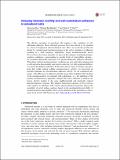| dc.contributor.author | Zhu, Xiaoying | |
| dc.contributor.author | Bouffanais, Roland | |
| dc.contributor.author | Yue, Dick K. P. | |
| dc.date.accessioned | 2017-05-08T14:26:44Z | |
| dc.date.available | 2017-05-08T14:26:44Z | |
| dc.date.issued | 2015-09 | |
| dc.date.submitted | 2015-06 | |
| dc.identifier.issn | 1932-1058 | |
| dc.identifier.uri | http://hdl.handle.net/1721.1/108734 | |
| dc.description.abstract | The effective migration of amoeboid cells requires a fine regulation of cell-substratum adhesion. These entwined processes have been shown to be regulated by a host of biophysical and biochemical cues. Here, we reveal the pivotal role played by calcium-based mechanosensation in the active regulation of adhesion resulting in a high migratory adaptability. Using mechanotactically driven Dictyostelium discoideum amoebae, we uncover the existence of optimal mechanosensitive conditions—corresponding to specific levels of extracellular calcium—for persistent directional migration over physicochemically different substrates. When these optimal mechanosensitive conditions are met, noticeable enhancement in cell migration directionality and speed is achieved, yet with significant differences among the different substrates. In the same narrow range of calcium concentrations that yields optimal cellular mechanosensory activity, we uncovered an absolute minimum in cell-substratum adhesion activity, for all considered substrates, with differences in adhesion strength among them amplified. The blocking of the mechanosensitive ion channels with gadolinium—i.e., the inhibition of the primary mechanosensory apparatus—hampers the active reduction in substrate adhesion, thereby leading to the same undifferentiated and drastically reduced directed migratory response. The adaptive behavioral responses of Dictyostelium cells sensitive to substrates with varying physicochemical properties suggest the possibility of novel surface analyses based on the mechanobiological ability of mechanosensitive and guidable cells to probe substrates at the nanometer-to-micrometer level. | en_US |
| dc.description.sponsorship | SUTD-MIT International Design Centre (IDC) (IDG31400104) | en_US |
| dc.language.iso | en_US | |
| dc.publisher | American Institute of Physics (AIP) | en_US |
| dc.relation.isversionof | http://dx.doi.org/10.1063/1.4931762 | en_US |
| dc.rights | Article is made available in accordance with the publisher's policy and may be subject to US copyright law. Please refer to the publisher's site for terms of use. | en_US |
| dc.source | PMC | en_US |
| dc.title | Interplay between motility and cell-substratum adhesion in amoeboid cells | en_US |
| dc.type | Article | en_US |
| dc.identifier.citation | Zhu, Xiaoying; Bouffanais, Roland and Yue, Dick K. P. “Interplay Between Motility and Cell-Substratum Adhesion in Amoeboid Cells.” Biomicrofluidics 9, no. 5 (September 2015): 054112. © 2015 AIP Publishing LLC | en_US |
| dc.contributor.department | Massachusetts Institute of Technology. Department of Mechanical Engineering | en_US |
| dc.contributor.mitauthor | Yue, Dick K. P. | |
| dc.relation.journal | Biomicrofluidics | en_US |
| dc.eprint.version | Final published version | en_US |
| dc.type.uri | http://purl.org/eprint/type/JournalArticle | en_US |
| eprint.status | http://purl.org/eprint/status/PeerReviewed | en_US |
| dspace.orderedauthors | Zhu, Xiaoying; Bouffanais, Roland; Yue, Dick K. P. | en_US |
| dspace.embargo.terms | N | en_US |
| dc.identifier.orcid | https://orcid.org/0000-0003-1273-9964 | |
| mit.license | PUBLISHER_POLICY | en_US |
